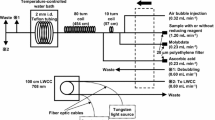Conclusions
Our results demonstrate two possible sources of error in the field determination of lignins and lignosulfonates. They are caused by:
-
1.
Possible microbial degradation of PME, particularly under anaerobic conditions.
-
2.
Interference by the bisulfide ion under anaerobic conditions.
One practical application of these observations is that lignins and lignosulfonates as measured by U.V. spectrophotometry cannot be used as a conservative indication of PME in receiving waters, particularly where part of the system is anaerobic. This conclusion probably applies also to other non-specific techniques. Lignins and lignosulfonates have been used as natural tracers in preference to fluorescent dyes (see, for example, WILANDER et al. 1974) because dyes are expensive, they do not change physical conditions of the system and, because they have been previously regarded as conservative, allow ample time for observations of dispersion. AUNINS and TUPREINE (1974) also report coagulation of lignosulfonic complexes on addition to seawater, the degree of this effect depending on salinity, temperature, and degree of turbulent mixing.
Interference from the bisulfide ion can be removed by purging with air or nitrogen. If it is necessary to store water samples before analysis, they must be sterilized effectively, such as by membrane filtration. Field samples filtered through. 22μ or 45μ membrane filters and held in covered test tubes maintained their U.V. absorbance values unchanged for at least 3 months.
Similar content being viewed by others
References
AUNINS, E., and TUPUREINE, A. Biol. Balt. Morya.1: 76–85 (Russian). Chem. Ab. No. 480176 (1974).
BAUMGARTNER, D. J., FELDMAN, M. H., and GIBBONS, C. L. Water Res.5: 533 (1971).
BROCK, T. D. Principles of Microbial Ecology. PrenticeHall Inc., New Jersey, 1966.
DOBBS, R. A., WISE, R. H., and DEAN, R. B. Water Res.6: 1173 (1972).
GANCZARCZYK, J., and OBIAGA, T. Water Res.8: 857 (1974).
GOLDHABER, M. B., and KAPLAN, I. R. Mar. Chem.3: 83 (1975).
LEITHE, W. The analysis of organic pollutants in water and waste water. Ann Arbor, Michigan, 1973.
MRKVA, M. J. Water Poll. Contr. Fed.41: 1923 (1969).
WATKINS, S. H. J. Water Poll. Contr. Fed.42: R47 (1970).
WEXLER, A. S. Anal. Chem.36: 213 (1964).
WILANDER, A., KVARAS, H., and LINDELL, T. Water Res.8: 1037 (1974).
WILDISH, D. J., CARSON, W. A., CARSON, W. V., and Hull, J. L'Etang Inlet Survey I. Fish. Res. Board MS Rep. 1177, (1972).
Author information
Authors and Affiliations
Rights and permissions
About this article
Cite this article
Wildish, D.J., Poole, N.J. & Kristmanson, D.D. The effect of anaerobiosis on measurement of sulfite pulp mill effluent concentration in estuarine water by U.V. spectrophotometry. Bull. Environ. Contam. Toxicol. 16, 208–213 (1976). https://doi.org/10.1007/BF01685229
Published:
Issue Date:
DOI: https://doi.org/10.1007/BF01685229




